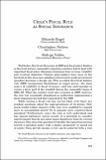| dc.contributor.author | Engel, Eduardo | |
| dc.contributor.author | Neilson M., Christopher | |
| dc.contributor.author | Valdés, Rodrigo | |
| dc.coverage.spatial | CHILE | es_ES |
| dc.date.accessioned | 2019-11-01T00:05:48Z | |
| dc.date.available | 2019-11-01T00:05:48Z | |
| dc.date.issued | 2013 | |
| dc.identifier.isbn | 978-956-7421-37-4 | |
| dc.identifier.uri | https://hdl.handle.net/20.500.12580/3791 | |
| dc.description | Well before the Great Recession of 2009 put fiscal policy debates in the front burner commodity-exporting countries had to deal with important fiscal policy dilemmas stemming from revenue volatility and eventual depletion. Chilean policymakers have been at the forefront in this area since adopting a fiscal rule to guide government spending decisions a decade ago. This so-called structural balance rule (SBR) incorporates fluctuations in copper prices—the main source of volatility in fiscal revenues—and was instrumental in saving a large part of the windfall during the commodity boom of 2005–08. When the country went into recession in 2009 however the rule was essentially abandoned as authorities implemented a fiscal expansion beyond that suggested by the SBR. | |
| dc.format | .pdf | |
| dc.format.extent | Sección o Parte de un Documento | |
| dc.format.medium | p. 393-425 | |
| dc.language.iso | eng | |
| dc.publisher | Banco Central de Chile | |
| dc.relation.ispartof | Series on Central Banking Analysis and Economic Policies no. 17 | |
| dc.rights | Attribution-NonCommercial-NoDerivs 3.0 Chile | * |
| dc.rights.uri | http://creativecommons.org/licenses/by-nc-nd/3.0/cl/ | * |
| dc.subject | POLÍTICA FISCAL | es_ES |
| dc.subject | CRISIS ECONÓMICA 2008 | es_ES |
| dc.subject | PRODUCTOS BÁSICOS | es_ES |
| dc.title | Chile’s fiscal rule as social insurance | |
| dc.type.doc | Artículo | |
| dc.file.name | BCCh-sbc-v17-p393_425 | |


